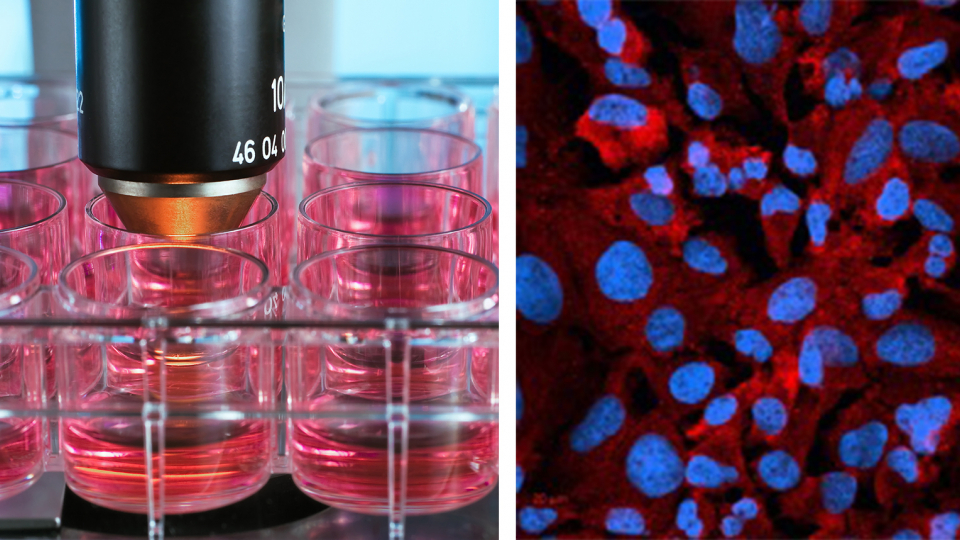Q&A: COVID-19 Vaccine Study Gains Attention
A new study from Lund University in Sweden on how the Pfizer-BioNTech COVID-19 vaccine affects human liver cells under experimental conditions, has been viewed more than 800,000 times in just over a week.

To the left: Petri dishes for cell cultures in the lab. To the right: Cells from the cell line the researchers used in the study. Photo: Massimo De Marinis and Yang de Marinis.
A new study from Lund University in Sweden on how the Pfizer-BioNTech COVID-19 vaccine affects human liver cells under experimental conditions, has been viewed more than 800,000 times in just over a week. The results have been widely discussed across social media – but the results have in many cases been misinterpreted. Two of the authors, Associate Professor Yang de Marinis (YDM) and Professor Magnus Rasmussen (MR), share their views.
How did this study come about?
YDM: A previous study from MIT has indicated that the SARS-CoV-2 virus mRNA can be converted to DNA and integrated into the human genome. Indeed, about 8 percent of human DNA comes from viruses inserted into our genomes during evolution. Does the Pfizer-BioNTech mRNA vaccine get converted to DNA or not? This has been the question our study aims to answer.
What did your study conclude?
YDM: This study does not investigate whether the Pfizer vaccine alters our genome. Our publication is the first in vitro study on the conversion of mRNA vaccine into DNA, inside cells of human origin. We show that the vaccine enters liver cells as early as 6 hours after the vaccine has been administered. We saw that there was DNA converted from the vaccine's mRNA in the host cells we studied.
MR: These findings were observed in petri dishes under experimental conditions, but we do not yet know if the converted DNA is integrated into the cells' DNA in the genome - and if so, if it has any consequences.
Why liver cells and why the specific dose?
YDM: About 18 percent of the vaccine accumulates in the liver just 30 minutes after the vaccine is injected in mice as reported by Pfizer in EMA assessment report, and therefore we chose to study liver cells. This also explains the choice of vaccine concentrations in our study, something we specifically address in the paper, which are 0.5-2% of the injection site concentration.
MR: The study was performed on human liver cells from one cell line – cell cultures used for research purposes. It is a good tool when studying molecular and cellular processes, they are easy to research, and since the cell lines are easily accessible, studies often start with various cell lines.
What are key limitations of the study?
MR: One should consider that cell lines differ from cells in living organisms, and therefore it is important that similar investigations are also studied in humans.
It is important to bear in mind that the liver cells in this study are more genetically unstable than our own liver cells.
YDM: One of the limitations of our study is that we don’t know if what we observed in this cell line could also happen in cells of other tissue types, and this needs to be addressed in follow-up studies.
The study has received a lot of media attention, what are your thoughts on that?
MR: We understood that the study would attract attention, but we think it is self-evident that this type of research should be pursued. We have a new vaccine, and it needs to be tested in cell and animal models and also in humans, in various ways. The result might be surprising, but it is also a bit surprising that such studies do not seem to have been carried out before.
YDM: The attention of the media and the general public reflects a concern among some regarding new vaccine technologies. This in itself motivates the need for further studies.
Based on this study, is there any reason to not get vaccinated?
MR: There is no reason for anyone to change their decision to take the vaccine based on this study.
What are the next steps in this research?
YDM: More research is needed. Data, especially data from vaccinated humans, will hopefully sort out the question marks. Whether our results are true for other cell types in humans, or if they are specific to mRNA vaccines, are among many questions for further research.
Publication: Alden, M., et al. Intracellular Reverse Transcription of Pfizer BioNTech COVID-19 mRNA Vaccine BNT162b2 In Vitro in Human Liver Cell Line. MDPI, (2023). DOI: 10.3390/cimb44030073
Original Story Source: Lund University

 Alerts Sign-up
Alerts Sign-up